
How this research initiative is facilitating RV industry growth
While listening to a conversation at the 2018 Xscapers Annual Bash between two different generations of RVers, Winnebago Product Planner Nick Davis, had one of those all-important lightbulb moments. Nick was listening to a more seasoned RVer share that he didn’t relate to some of the new and unique ways the next generation of RVers are approaching the lifestyle, but that he could respect and understand the desire to want to do things differently than past generations. It was clear that there was a new wave of RVers making their way into the market and Winnebago needed to make sure they were facilitating conversations to stay informed with the changing needs and preferences of the RVing community.
Winnebago has relied on valuable product feedback from their own owners’ group, WIT Club, for decades and has also had a growing involvement at various rallies and RV events, such as the RV Entrepreneur Summit. While these grass roots efforts to better understand the customer through product feedback have been successful and will continue to be an important part of the voice of customer efforts, Winnebago wanted to take it a step further. Although the relationship wasn’t formalized until later in the year, Nick’s experience at the Xscapers event was a great example of the insights that could be gained from working more closely with the Escapees RV Club. The company also stood out due to its community-focused nature and “total support network” for RVers, as well as its more than 60,000 members and 40+ years of experience in the industry.
For Travis and Melanie Carr, president and vice president of Escapees and founders of Xscapers, it was obvious that “RVers were underutilized” in the RVing industry. Their goal was to connect their community to a manufacturer who would listen, so that their valuable input would be taken into account for future designs. By observing interactions at shows and events, the Carrs made note that Winnebago was not only hearing the customer feedback, they were actually implementing it by coming out with product innovations based on those insights. The launch of the Horizon – Winnebago’s luxury Class A motorhome with a standout contemporary design – especially got their attention. This re-imagined diesel pusher resonated so much with Travis & Melanie that they even decided to purchase a Horizon of their own!
While the voice of the customer was being heard from various audiences and platforms, Escapees knew that “a combined voice goes a lot further” and wanted to help facilitate that level of communication between their diverse member base and Winnebago through a formal research initiative.
Innovation Through Insights
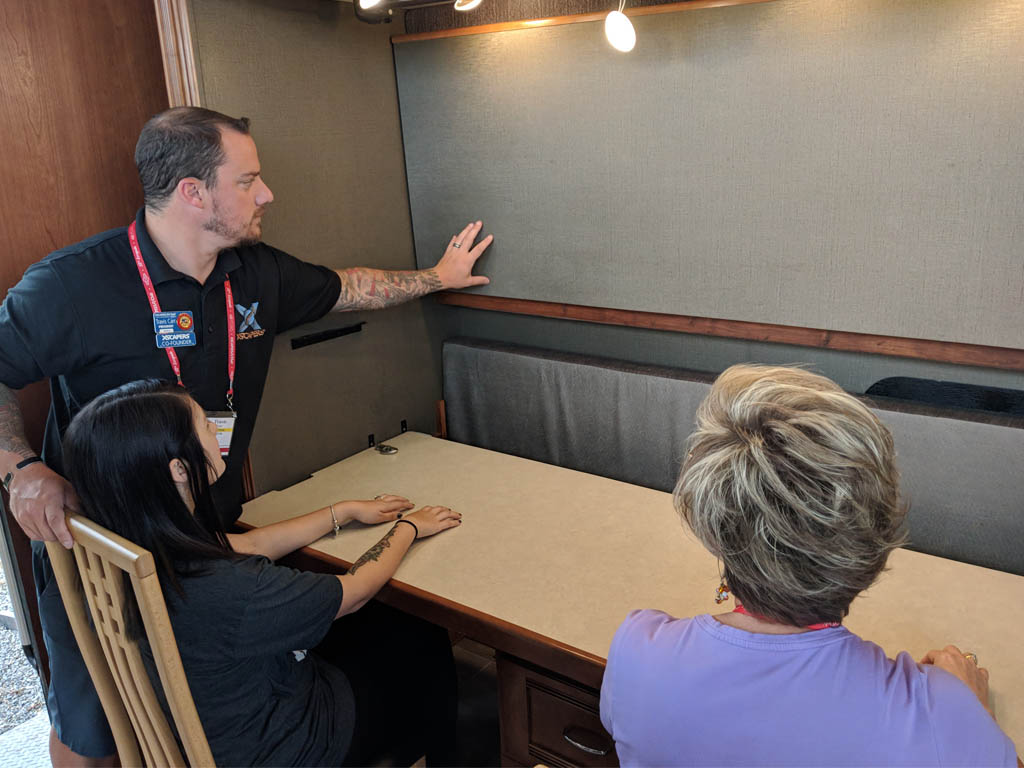
With more than fifty years of experience hosting the annual Grand National Rally, Winnebago knows the value of RVer events and wanted to be part of some of the great social and educational events that Escapees hosts throughout the year – including the annual Escapade. In 2018, Nick and the Winnebago team saw the 58th Escapade event as an opportunity to better understand who the Escapees are, get more exposure for the Winnebago brand, and do a lot of research. Since the event was only a state away in Missouri, about a dozen Winnebago team members drove down with around 10 motorhomes.
While initially unsure how their presence would be received, Winnebago was excited to be welcomed and embraced by the friendly Escapees community who were happy for the chance to provide their genuine thoughts on how the RVing lifestyle could be improved. At the event, Winnebago hosted targeted focus groups and workshops where they shared product mock-ups and collected feedback from Escapees members. They also spent time interviewing individual RVers and were especially impressed with some of the ways these owners “hacked the RV experience” with creative mods.
The feedback collected at this event helped to influence the redesign of the Winnebago Forza 38D floorplan – complete with a workspace that can be used by multiple people at once as a formal desk or craft area. Nick Davis notes, “it was an idea that was defined and developed by an entire team of people, not just Winnebago.”
Clearly, engaging with RV enthusiasts is a source of inspiration for Winnebago and, according to Travis and Melanie, Escapees members felt it was “uplifting to know the input they gave was actually implemented in a product.”
Making It Official
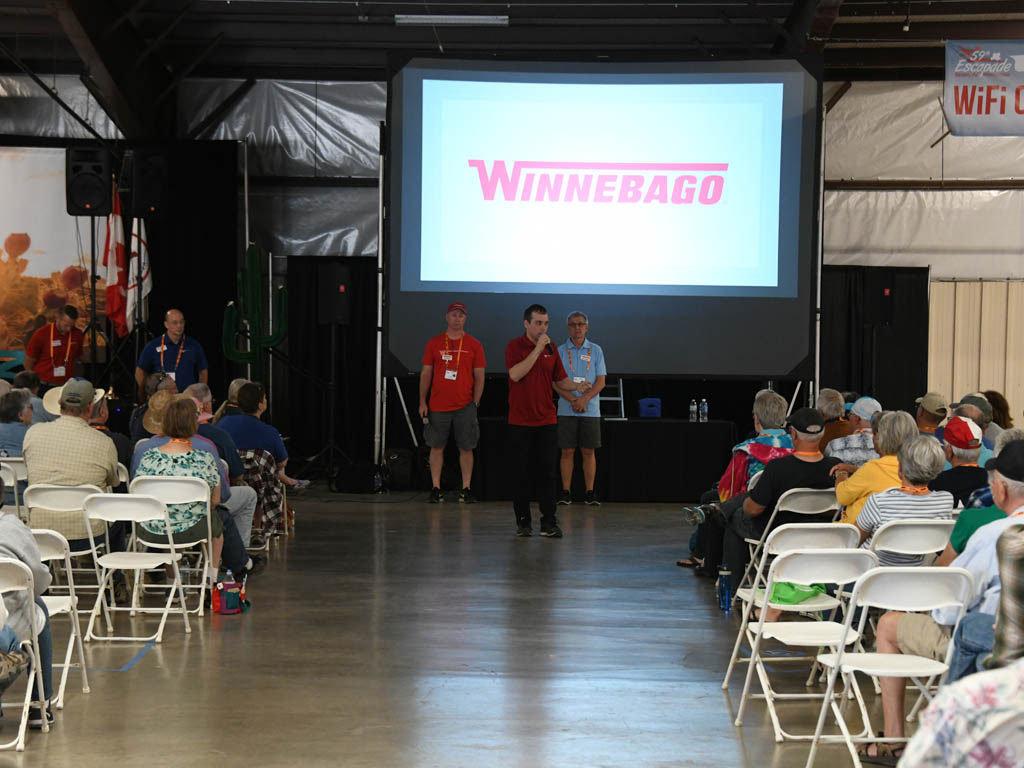
The success of this collaboration is what led to the establishment of a more formal, long-term working relationship to make sure this passionate group of RVers continues to speak into Winnebago’s product decisions. In fall of 2018, Escapees RV Club became Winnebago’s primary non-owner-specific research group – an important milestone for both organizations and their shared goals of furthering innovation and creating a better RVing experience.
Knowing the benefits of the more hands-on, in depth experience available at events, Winnebago expanded their presence at the 59th Escapade in March 2019 by bringing along the towable group as well and hosting multiple events – including an “Ask the Manufacturer” session to provide an opportunity for attendees to interact directly with representatives and learn more about current and future Winnebago projects. After the Q&A event, which was opened to more than 1,000 RV owners, attendees were welcomed to schedule appointments with the Winnebago Product Planners to give further insights and share more specific improvement ideas.
In addition to in-person events, Winnebago has furthered their research with Escapees by inviting a group of members to participate in their RV Experience Council in order to gain a deeper, more specific understanding of the customer experience and pain points, as well as offer an opportunity for members to participate in a broader range of research activities – including interviews and online discussion boards. In early 2019, nearly 1,500 Escapees members opted-in to Winnebago’s research panel, sharing detailed insight into how RVers use their rigs. Of course, any information collected is confidential and participants can opt-out at any time.
Through in-person interviews, surveys, event workshops, and online discussion boards, Winnebago has been able to engage with this diverse group of RVers and collect important feedback which has, along with other voice of customer efforts, led directly to enhancements in products.
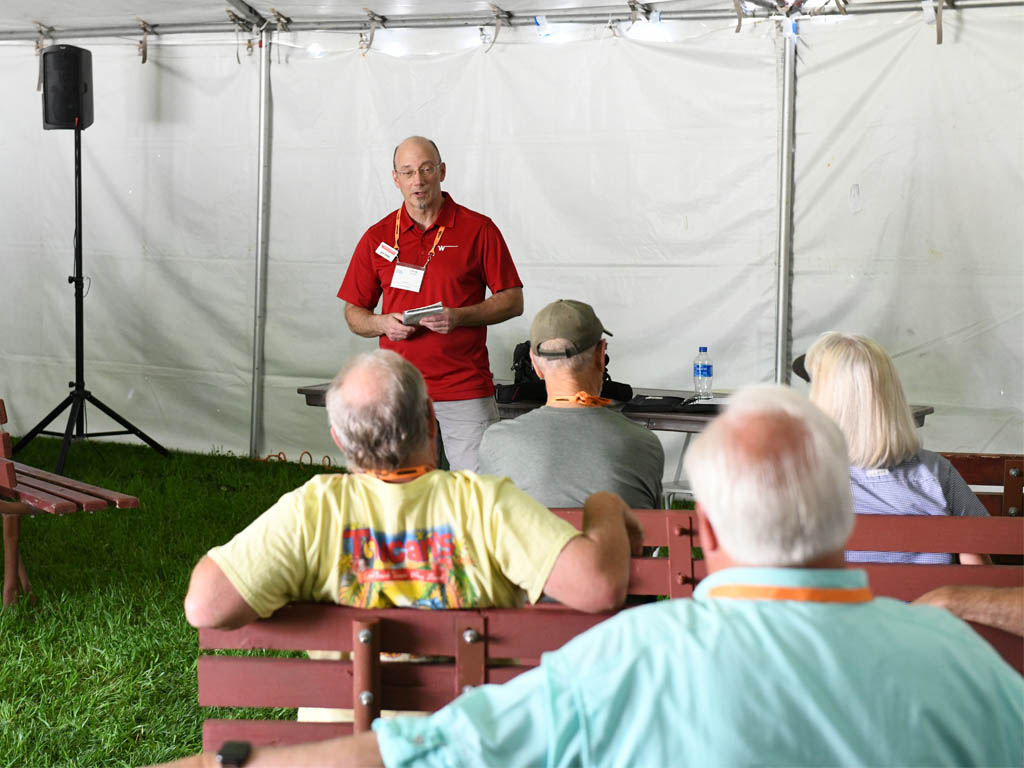
Future Collaborations
While the Winnebago-Escapees relationship has already helped to inspire multiple innovations, this is just the start. There are regular meetings to discuss ways to further these efforts and work together toward the goal of improving the RV lifestyle for current and future generations. Nick Davis explains it is important to “continue the relationship in a way that creates meaningful change for RVers.” Winnebago doesn’t want to just ask “what are the true needs of RVers and how are they evolving?,” but actually act on that feedback and make sure those insights are reflected in products.
Escapees RV Club has been providing support to the RVing community for more than 40 years and is now instrumental in facilitating input for Winnebago’s voice of customer efforts to improve RV design and overall experience.







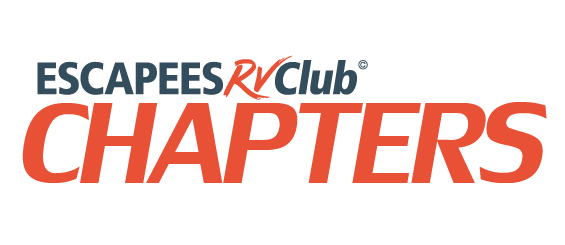
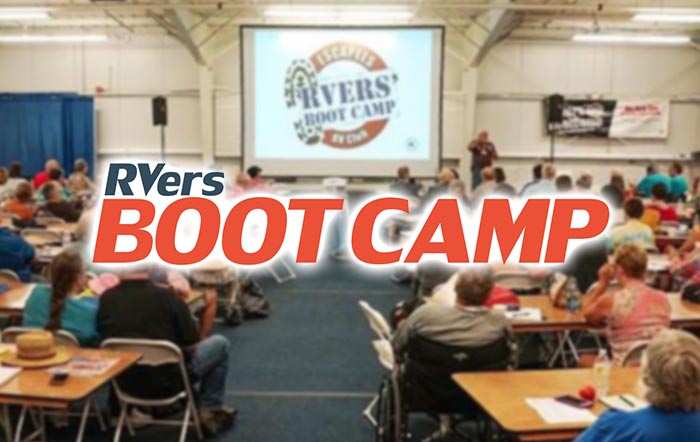
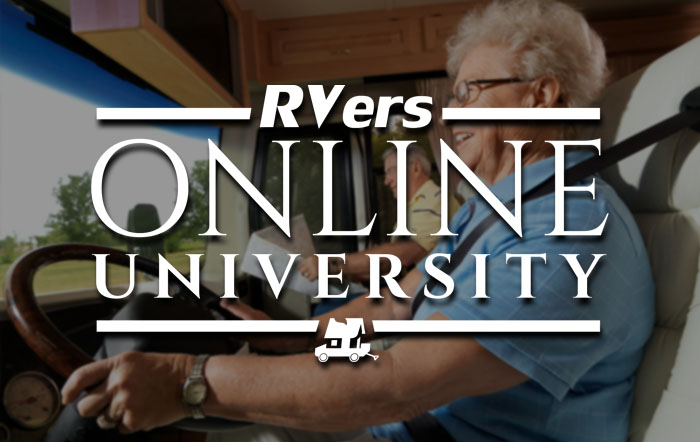

3 Responses
It’s great that there is a collaboration between Winnebago and RVing groups. But – (1) who are they actually soliciting feed back from and (2) are they really listening? Even though I am a member of both Escapees and of WIT I feel “in the dark” about what decisions they are arriving at. What exactly are they learning? How will future designs be different? How is Winnebago evolving it’s designs?
I spent most of my career in OEM automotive upper management. I saw many times where new product designers paid more attention to design trends (both good and bad) than they did to the customer. They paid even more attention to what their competitor manufacturers were doing (good or bad) than to what made sense to and appealed to customers. (Example – why so many autos offered only with totally black interiors? In the SW sunlight is so intense one can actually get burnt on the hot black seats! It was because designers decided that all black was the “cool” look to have – did not care about practicality to daily drivers at all). I am afraid that I seeing similar things with RV manufacturers.
My wife & I have been full timers in our Adventurer for a number of years now. We have attended – and still attend – many large RV shows – on both coasts – and visited many dealers and as well as smaller, more local shows. But for the most part – rather than being “blown away” by new models we come away feeling that many new models have strayed away from some of the small features and user friendly design features which we have found very important in our 2005 which make real full time living more convenient, pleasant and possible.
For example – we toured the new Horizon models at several shows, and both came away with the feeling that it’s interior was so WHITE that it did not feel homelike at all – instead more like a hospital. Toured the new Adventurer and found it was not only missing some of the small touches and details which our 2005 already had (or used to have), but it displayed some design features which made no sense – a big step backward. One of these was the side entry door which did not open all the way – it was limited to 90 degree, perpendicular to the body, by a gas retaining strut – (most of which I have seen snap off in many other RVs (of many different brands) after limited use). The door was limited in this way because the outside awning strut was located right next to the side entry door hinge. (But why? Could have located the awning strut forward some to clear the doorway). But with the door opening only 90 degrees it could not swing back out of the way, and the thickness of the door (3-5″) narrowed the entry width into the coach. We know that there are times when large items have to be moved into and out of the RV – like furniture. And to do so you need every mm of door width to squeeze such items through. In our model we barely were able to take out the 1 piece Splendide washer. As well as the 27″ CRT TV. Or to replace the large heavy “recliner”. These would have been impossible in the new Adventurer because of the narrower doorway.
Now I realize that this doorway design is not necessarily on each floor plan – but it made us wonder on that particular floor plan – “What were they thinking”. How did this pass any user-friendly testing?
OK you say – that is just 1 feature. But the list goes on. Location of light switches is critical. Just as in any home there is a flow through the unit, and switches should be conveniently located as it’s occupants move about. I do not want or need to be “hunting” for a light switch every time I enter the BR for example. Same problem with the newer multiplex systems which many new coaches have gone to. May be convenient to be able to control lighting throughout the coach from single locations – but when I enter a room and just want to turn the light on there is no such thing as a simple toggle switch there any more. Instead I have to hunch down and study the multiple switches on the multiplex control and try to figure out which one controls what. Or how about having showers with molded in shelves to hold soap & shampoos? Some models have none, and of the models which did they did not offer retaining straps across them to hold these items in place when traveling. Our 2005 had them – standard.
I can go on – to such things as having as much kitchen counter space as possible. So why do there continue to be some models which do not have fold flat stove top covers to help with that? Why are there some models which have no light switches right by – and in – the entry door way? (Not so much Winnebago – but some competitors).
* Why don’t many manufacturers include a ceiling vent fan over the bed? Everyone knows that when boondocking most cannot run their A/C. So on hot summer nights having ventilation there is wonderful! But I had to cut a 14″ x 14″ hole in the roof myself to install one. How come this need was not obvious to RV designers years ago?
* Newer features we like include electric fireplaces, “L” shaped couches and solar pre-wiring.
* I wish more coaches would include LiFePO4 house batteries as standard – instead of the old fashioned lead-acid golf cart batteries which have been used for over 60 years – but which never got any better. They are really heavy and just do not seem to last very long in RVs no matter what. Most coaches should also include a battery meter so the owners can really see what is going on with their house batteries.
* Models should include a small roof solar panel which does nothing except keep the engine battery charged up while parked for extended periods. (Our 2005 included that as standard – though for the house batteries, not chassis. I re-wired it over to the engine battery because we use and charge up our house batteries daily, but people tend to totally forget about the engine battery. It will self-discharge if just allowed to sit there.) The manufacturers obviously realized this engine battery discharge problem because many included a dash “Battery Boost” switch to enable the use of the chassis batteries to help start the engine. But since the engine battery also powers other things like leveling systems, slides and the retractable side step it is critical to keep it charged up all the time anyway.
* Many models need larger grey water tanks. In our experience the grey tank is easily the 1st to fill up – often weeks before the black tank.
* How about offering a real “Boondocking” package? One that is really useful and practical? Such as having sufficient solar panels to charge up a large Lithium battery bank, working through a large inverter? How about offering larger tanks too? Or including a sealed trash bay specifically designed to hold trash while out boondocking before we are able to responsibly dispose of it?
Anyway – we could go on. There are many features and details which are important in RV design, but I really wonder how well the manufacturers are actually listening? All too often the only thing they seem to be concerned about are the exterior full body paint colors. Or the interior design collection colors. They often seem to pay more attention to the colors of the bedspread, or window treatments than anything else. Not saying that having pleasant interior colors (NOT glossy antiqued cabinets – who came up with those???) are not important, but I am saying that there are many, many other features which can really enhance RV living. And it has become apparent to me that most RV designers have never really lived in an RV. Because if they had many other features would become more critical to them – and you would see that in production models.
I just wish that all manufacturers would actually listen to the real users of their products to help make them more usable and desirable.
I am ready and willing to offer my thoughts – are they ready and willing to really listen?
Thank you for your feedback!
There isn’t truly a ‘short’ answer to your questions, but I’ll try to be brief. For the majority of interior changes, they take time. A lot of time. For example, the Forza mentioned in the article was the result of conversations and focus groups that happened two years prior. This lag is due to a number of factors, including data collection, testing prototypes, working with parts manufacturers, redesigning production processes, and making adjustments at every step as necessary.
From my own conversations with Winnebago reps, I have learned that preferences are not as universal as we often think they are. RVers are unique when it comes to what they want in their home on wheels. Not all prefer boondocking just as not all prefer campgrounds. And in either environment, preferred features can vary greatly. This is where their consumer research programs, focus groups, and workshops become very important. They collect data through each of these interactions in order to see which changes are most likely to appeal to the widest range of RVers, making these changes more cost-effective so that their RVs remain as affordable as possible.
I hope this helps answer some of your concerns. I’ll share your comment with our Winnebago contacts, too.
Thank you for your quick response.
I realize that each RVer is different, and that not all would want a boondocking package. But boondocking – as a practical RV option – has become more and more popular amongst many – if not most – of the RVers we talk with. But I did suggest it as an optional package – not mandatory. Though having a really good battery system is more and more critical to many, especially as the use of residential refrigerators and electric cooktops increase in many models.
My main point is that there are many relatively small design features and conveniences which can make a big difference to RV occupants. That is one of the reasons we love our 2005 so much – because it has many features which we have grown to appreciate over time. And we noticed that some of these are missing on new models – very puzzling to us.
I appreciate your passing along my comments. Would love to have some input on future products.
Thank you!